
English | MP4 | AVC 1280×720 | AAC 44KHz 2ch | 3.5 Hours | 1.02 GB
Getting Better at JavaScript Syntax, Modules, Objects, and Environments (DOM and Node)
Developers everywhere use JavaScript to build websites and desktop applications. While it’s relatively simple to learn JavaScript basics, it can be a difficult language to truly master.
This course helps you transition from JavaScript novice to JavaScript pro by teaching you the techniques and practices used by the seasoned practitioner. The only prerequisites are beginning level JavaScript experience, access to a good code editor (like Visual Studio Code), and the desire to improve.
- Gain experience writing robust high quality JavaScript code
- Master the use of semi-colons and JavaScript ASI (Automatic Semicolon Insertion)
- Discover where to put curly braces and why that actually matters
- Learn about equality, variables, functions, avoiding globals, and strict mode
- Explore object creation, creational patterns, privacy, and immutability
- Understand how to define and use modules to organize code
- Learn how to appropriately interact with HTML/CSS and the browser’s DOM
- Understand how to lint code with ESLint and bundle code using webpack
Table of Contents
01 Welcome To The Course
02 About The Author
03 How To Access Your Working Files
04 Automatic Semicolon Insertion
05 Curly Braces
06 Equality
07 Variables
08 Functions
09 Avoiding Globals
10 Strict Mode
11 Object Literals
12 Factory Pattern
13 Using Prototypes
14 Constructor Pattern
15 Classes
16 Privacy
17 Immutability
18 How This Works
19 The Basic Module Pattern
20 The Revealing Module Pattern
21 ES2015 Modules
22 Decoupling Javascript And HTML
23 Decoupling Javascript And CSS
24 Avoiding Excessive DOM Changes
25 Intro To NPM
26 Acquiring And Using ESLINT
27 Webpack For Client Code
28 Webpack For Server Code
29 Using Environment Variables
30 Conclusion
Resolve the captcha to access the links!